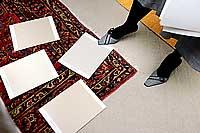True colors: Originator of Devine Paint helps Northwestern homeowners choose their hues

Until just a few years ago, Gretchen Schauffler was basically an Oregon mom looking for a job that would allow her to stay home with her four kids. Now, as the originator of Devine Paint, she's riding the crest of a wave in color usage spurred by homeowners who want more excitement than plain white walls but aren't sure how to accomplish it successfully.
"I was a nobody, not an interior designer, not a well-known artist," says Schauffler, a tiny, trim woman who's a whirlwind of energy. "I was just a stay-at-home mom who said, 'We need to change.' "
Trained as a graphic designer at Portland State University, she was living in Lake Oswego just south of Portland and working as an in-home color consultant. Problem was, she couldn't find interior paint she could wholeheartedly recommend to clients.
"It had to have complexity and depth and grow to 400 square feet and have the right sense of vibrancy, and it could not overpower that muted light," Schauffler says, rapid-fire.
So she began banging on the doors of a century-old Oregon firm, Miller Paint, until she finally got a hearing with its new president and CEO, Steve Dearborn. Miller sells exclusively in Oregon and Washington.
She wanted Dearborn to create a new premium paint that would have the consistency of face cream (to cover in one coat), very little odor ("I don't like watery, splattery things that smell bad") and that complexity she so desired. Plus she wanted the colors arranged into foolproof palettes so customers couldn't make mistakes.
"After talking with her 10 minutes, I knew we had it," says Dearborn. He has three decades in the paint business, including experience with the Ralph Lauren line. "Gretchen has this ability to describe color in a way I've never heard before. Not only can she visualize color, but she can tell you why it's right in the environment you're working in."
The result is a paint that's chemically unlike others, a "proprietary resin" whose closest competitor is another paint newcomer, C2, made by a New York-based company, The Coatings Alliance.
Word-of-mouth
Following its launch in March 2001, Devine Color (so named, Dearborn muses, because Gretchen couldn't spell "divine") has become something of a cult product, even at $26.95 a gallon. It's been spotlighted in numerous national magazines, including House & Garden and Metropolitan Home, and word-of-mouth is spreading.
"Up until about a year ago, nobody had heard of it," recounts Seattle interior designer Elizabeth M. Slick. "I had to bring it up to my clients. Now they're mentioning it to me."
Slick says clients like the Devine Color concept of a very carefully edited palette that's divided by color groups and finishes for walls, trim and ceilings. "It's the sort of limited choice clients can wrap their heads around and not become overwhelmed." (Rather than offering literally thousands of color choices, as most paint companies do, Schauffler offers just 128 arranged in 11 color palettes that are specifically geared to look good in the Northwest's filmy, often gray light.)
Slick likes the colors, which professional painters tell her are great to apply.
"They're very rich, very beautiful. If you want very urban, sophisticated colors, you can find them. If you want something brighter, more fun, you can find them as well. Homeowners can find their own comfort level."
And, thanks to another Schauffler brainchild, homeowners can try out those colors with minimum investment and confusion, via a $3.49 "minipouch" sample of wall paint she created to foolproof the selection process.
Talking color
Schauffler still does $350-an-hour, in-home color consultations (she has a long waiting list), and one recent gray day found her in Ballard at the home of Dana and David Kennedy.
They moved into their first home last year, eager to repaint its interior, but "didn't want to rush and just do colors we liked without thinking about how they work together," explains Dana, a pharmacist who heard about Schauffler and Devine Color from Portland friends.
Schauffler calls her product "girl paint," and is unapologetically feminine in her approach to color selections. Wall paint is a home's "skin," she explains to Kennedy. Furnishings are like clothes. "My job is to make sure this skin color — the paint on the wall — is right for all the shirts and pants."
It's when she starts moving quickly around Kennedy's house and talking color that Schauffler's finely tuned eye becomes obvious.
Pointing to a brown leather sofa, Schauffler announces it would be good to "pull out the purple" for use elsewhere. Kennedy is amazed. She says she never saw purple tones in the leather, but now that it's been pointed out, she can see them.
Likewise, pointing to the red in a Persian carpet, Schauffler notes its yellowish cast. She uses it to help Kennedy pick her primary "skin" color, something called "Devine Oat" that sure enough has some yellow.
What's not in her collection is plain old white. Schauffler says she loves using it as a color (for example, her towels are white), but not as a background — at least not in the often-gloomy Northwest. "The reality of white is that it's not able to produce light; it can only reflect light. So you don't have white on a wall; you have 30 percent gray on a wall."
Next, the world
And that brings up her philosophy about picking correct colors for this area. In the Northwest, she explains, the "nuance of color gets lost because of the gray and dark. So what you do is create contrast."
The key, she says, is balancing "the weight of color" in a room. For example, in the Kennedys' living room, the dark-brown sofa might be an 8 on a scale of 1 to 10. The medium golden beige tiles surrounding the fireplace might be a 5. Pick a color that has a "weight" of 3, and even though it has substantial pigment, "it can't be dark because it's lighter than what you own."
"But if you want to go with a darker, richer color, you can put a 6 on the wall, and if your couch is a 4 and your floor a 5, your furnishings will look lighter."
In other words, she's playing with the contrast between the wall color and the room's contents, including floor color. And she's thinking in context of everything that's in the room, which she says is the key to successful color selection.
For that reason she says there are no colors off-limits in the Northwest. "Every color is wonderful as long as it's in a relationship because colors are meant to live in relationships."
Devine Color may have been created for the Northwest, but it's already spread well beyond it, thanks to licensing agreements Miller Paint signed with other manufacturers. Now available in many parts of the country, it recently entered England and Ireland. Next year, Schauffler plans to come out with a national color palette, and a book on her color philosophy.
"I think we're in the very early stages, we're just scratching the surface," says Dearborn, Miller's president. "There's no doubt in my mind that next year she'll be on national TV," and then a vastly enlarged audience can get its mind around her color sense — and her fanciful color names.
For example, there's Devine Sumatra. "It's like if you take two-thirds coffee and one-third whole milk and add a little bit of nutmeg," Schauffler explains. And Devine Butter. "It's like a yellow sherbet that actually has a light frost on top."
Devine Almond? It's "like you take light stainless steel and add blues and greens to it, and that's almond," Schauffler explains. Why, of course.
Elizabeth Rhodes: erhodes@seattletimes.com

